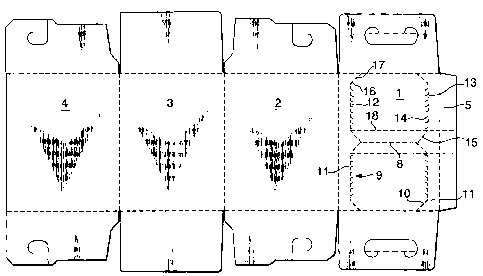Some of the information on this Web page has been provided by external sources. The Government of Canada is not responsible for the accuracy, reliability or currency of the information supplied by external sources. Users wishing to rely upon this information should consult directly with the source of the information. Content provided by external sources is not subject to official languages, privacy and accessibility requirements.
Any discrepancies in the text and image of the Claims and Abstract are due to differing posting times. Text of the Claims and Abstract are posted:
| (12) Patent: | (11) CA 2413626 |
|---|---|
| (54) English Title: | CARTON FOR BEVERAGE CONTAINERS |
| (54) French Title: | CARTON POUR CONTENANT DE BOISSONS |
| Status: | Expired and beyond the Period of Reversal |
| (51) International Patent Classification (IPC): |
|
|---|---|
| (72) Inventors : |
|
| (73) Owners : |
|
| (71) Applicants : |
|
| (74) Agent: | MOFFAT & CO. |
| (74) Associate agent: | |
| (45) Issued: | 2006-06-27 |
| (22) Filed Date: | 2002-12-05 |
| (41) Open to Public Inspection: | 2004-06-05 |
| Examination requested: | 2002-12-05 |
| Availability of licence: | N/A |
| Dedicated to the Public: | N/A |
| (25) Language of filing: | English |
| Patent Cooperation Treaty (PCT): | No |
|---|
| (30) Application Priority Data: | None |
|---|
A carton for beverage containers has interconnected side panels, top panel and
bottom panel, and sealable ends. An improved opening structure is configured
in
the top panel comprising a paid of opening flaps each extending from an end of
the
top panel to the mid-line thereof. The mid line is a punch open line of
weakness.
The opening flaps are substantially rectangular, flanked on their side edges
by
structural support panels, and joined to the stiffening panels by lines of
weakness.
Note: Claims are shown in the official language in which they were submitted.
Note: Descriptions are shown in the official language in which they were submitted.

2024-08-01:As part of the Next Generation Patents (NGP) transition, the Canadian Patents Database (CPD) now contains a more detailed Event History, which replicates the Event Log of our new back-office solution.
Please note that "Inactive:" events refers to events no longer in use in our new back-office solution.
For a clearer understanding of the status of the application/patent presented on this page, the site Disclaimer , as well as the definitions for Patent , Event History , Maintenance Fee and Payment History should be consulted.
| Description | Date |
|---|---|
| Time Limit for Reversal Expired | 2010-12-06 |
| Letter Sent | 2009-12-07 |
| Grant by Issuance | 2006-06-27 |
| Inactive: Cover page published | 2006-06-26 |
| Pre-grant | 2006-04-04 |
| Inactive: Final fee received | 2006-04-04 |
| Inactive: IPC from MCD | 2006-03-12 |
| Notice of Allowance is Issued | 2006-02-20 |
| Letter Sent | 2006-02-20 |
| Notice of Allowance is Issued | 2006-02-20 |
| Inactive: Approved for allowance (AFA) | 2005-12-14 |
| Letter Sent | 2005-10-18 |
| Amendment Received - Voluntary Amendment | 2005-07-22 |
| Inactive: S.29 Rules - Examiner requisition | 2005-03-22 |
| Inactive: S.30(2) Rules - Examiner requisition | 2005-03-22 |
| Application Published (Open to Public Inspection) | 2004-06-05 |
| Inactive: Cover page published | 2004-06-04 |
| Amendment Received - Voluntary Amendment | 2003-07-30 |
| Amendment Received - Voluntary Amendment | 2003-07-30 |
| Letter Sent | 2003-04-04 |
| Inactive: First IPC assigned | 2003-03-12 |
| Inactive: Single transfer | 2003-02-28 |
| Inactive: Courtesy letter - Evidence | 2003-02-04 |
| Inactive: Filing certificate - RFE (English) | 2003-01-27 |
| Filing Requirements Determined Compliant | 2003-01-27 |
| Letter Sent | 2003-01-27 |
| Application Received - Regular National | 2003-01-27 |
| All Requirements for Examination Determined Compliant | 2002-12-05 |
| Request for Examination Requirements Determined Compliant | 2002-12-05 |
There is no abandonment history.
The last payment was received on 2005-11-07
Note : If the full payment has not been received on or before the date indicated, a further fee may be required which may be one of the following
Please refer to the CIPO Patent Fees web page to see all current fee amounts.
| Fee Type | Anniversary Year | Due Date | Paid Date |
|---|---|---|---|
| Application fee - standard | 2002-12-05 | ||
| Request for examination - standard | 2002-12-05 | ||
| Registration of a document | 2003-02-28 | ||
| MF (application, 2nd anniv.) - standard | 02 | 2004-12-06 | 2004-11-05 |
| Registration of a document | 2005-02-18 | ||
| MF (application, 3rd anniv.) - standard | 03 | 2005-12-05 | 2005-11-07 |
| Final fee - standard | 2006-04-04 | ||
| MF (patent, 4th anniv.) - standard | 2006-12-05 | 2006-11-09 | |
| MF (patent, 5th anniv.) - standard | 2007-12-05 | 2007-11-05 | |
| MF (patent, 6th anniv.) - standard | 2008-12-05 | 2008-11-05 |
Note: Records showing the ownership history in alphabetical order.
| Current Owners on Record |
|---|
| MOLSON CANADA 2005 |
| Past Owners on Record |
|---|
| BRUCE SMITH |